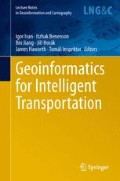Abstract
The accessibility evaluation of public transport is based on commuting to work conditions in Czech municipalities. Searching in time schedules are supported by client-server parallel processing. Three indicators are calculated for each municipality, district and region. Their evaluation proves the significant differences between commuting times. It indicates that traditional commuting pattern still persists in time schedules. The analysis of how regional differences in accessibility are changed according to commuting time intervals shows that accessibility for late morning is significantly decreased (compare to early morning) in all districts except of Prague and surrounding districts. The most dramatic drop of accessibility (more than 4 times) is recognised in the central part of the country. The combined evaluation of both-way accessibility for public transport discovers areas with serious restrictions on commuting to afternoon and night work shift using.
Access this chapter
Tax calculation will be finalised at checkout
Purchases are for personal use only
References
Geurs KT, Ritsema van Eck JR (2001) Accessibility measures: review and applications. RIVM Report 408505 006. National Institute of Public Health and the Environment
Vanderbulcke G, Steenberghen T, Thomas I (2009) Mapping accessibility in Belgium: a tool for land-use and transport planning? J Transp Geogr 17(1):39–53
Geurs K, Wee B (2004) Accessibility evaluation of land-use and transport strategies: review and research directions. J Transp Geogr 12(2):127–140
Ivan I (2010) Docházka na zastávku a její vliv na dojížďku do zaměstnání. Geografie 115(4):393–412. ISSN:1212-0014
Hagerstrand T (1970) What about people in regional science? People Reg Sci Assoc 24(1):7–21
Cebollada A (2009) Mobility and labour market exclusion in the Barcelona metropolitan region. J Transp Geogr 17(3):226–233
Hůrský J (1978) Regionalizace České socialistické republiky na základě spádu osobní dopravy. Studia Geographica, Geografický ústav ČSAV, Brno, p 182
Marada M, Květoň V, Vondráčková P (2010) Doprava a geografická organizace společnosti v Česku. Česká geografická společnost, Geographica. Praha, p 165
Križan F (2007) Regionálna typológia územia Bratislavy na základe dostupnosti supermarketov a hypermarketov. Geografický časopis 59(4):373–385
Currie G (2010) Quantifying spatial gaps in public transport supply based on social needs. J Transp Geogr 18:31–41
Yigitcanlar T, Sipe N, Evans R, Pitot M (2007) A GIS-based land use and public transport accessibility indexing model. Aust Plan 44(3):30–37
Goodchild MF, Jannele DG (2004) Spatially integrated social science. Oxford University Press, Oxford, p 456. ISBN:0-19-515270-0
Šeděnková M, Horák J, Ivan I, Fojtík D (2009) Hodnocení rozdílů při sledování dojížďky do zaměstnání jedním či oběma směry. In: Proc. Sympozium GIS Ostrava 2009, Ostrava, p 13
Ivan I, Horák J, Šeděnková M (2009) Public transport accessibility in the Czech Republic. In: Proceedings of ERSA congress, Lodz, Poland, p 18, 25–29 Aug 2009
Transport Yearbook (2011) Ministry of transportation, Prague. https://www.sydos.cz/cs/rocenka_pdf/Rocenka_dopravy_2011.pdf
Horák J, Šeděnková M, Horáková B (2008) Public transport accessibility based on time schedule analyses. In: Svatoňová H et al Geography in Czechia and Slovakia. Theory and practice at the onset of 21st Century. Brno, p 500. ISBN:978-80-210-4600-9
Mavoa S, Witten K, McCreanor T, O’Sullivan D (2012) GIS based destination accessibility via public transit and walking in Auckland, New Zealand. J Transport Geogr 20(1):15–22
Jánošíková Ľ, Kubáni A (2000) Dopravná dostupnosť obcí. Komunikácie 2(4):9–15. ISSN:1335-4205
Seidenglanz D (2007) Dopravní charakteristiky venkovského prostoru. Katedra Regionální geografie a regionálního rozvoje PřF Masarykovy univerzity v Brně, Disertační práce. Brno, p 196
Marada M, Květoň V (2006) Význam dopravní obslužnosti v rozvoji venkovských oblastí. In Proceedings of the conference “Venkov je náš svět”. Czech Agriculture University Prague, pp 422–431
Kraft S, Vančura M (2008) Regionální vyhodnocení efektivity dopravního systému České republiky a jeho prostorových dopadů. XI. Mezinárodní kolokvium o regionálních vědách. KRES, ESF, Brno, pp 252–260. ISBN:978-80-210-4625-2
Salon D (2009) Neighborhoods, cars, and commuting in New York City: a discrete choice approach. Transport Res A Pol 43(2):180–196
Lei TL, Church RL (2010) Mapping transit-based access: integrating GIS, routes and schedules. Int J Geogr Inf Sci 24:283–304
CSU (2013) Analýza: Ženy pracují na směny stejně často jako muži, p 6. http://www.czso.cz/csu/csu.nsf/informace/czam110413analyza13.doc
Fojtík D, Horák J, Šeděnková M, Ivan I (2009) Software support for automatic creating database of public transport connections. In: Proceedings of international Carpathian control conference ICCC 2009, Zakopane, Poland, pp. 517–520, 24–27 May 2009. ISBN:8389772-51-5
Trčka J (2013) Vývoj dopravní obslužnosti v ČR ve vybraném období. Diploma thesis, VSB-TU Ostrava
Acknowledgments
The data and the transport searching engine are provided by courtesy of CHAPS Ltd. Application has been developed as a part of Higher Education Development Fund—FRVŠ 956/2013/B1.
Author information
Authors and Affiliations
Corresponding author
Editor information
Editors and Affiliations
Rights and permissions
Copyright information
© 2015 Springer International Publishing Switzerland
About this chapter
Cite this chapter
Horák, J., Ivan, I., Fojtík, D. (2015). Time of Day Dependency of Public Transport Accessibility in the Czech Republic. In: Ivan, I., Benenson, I., Jiang, B., Horák, J., Haworth, J., Inspektor, T. (eds) Geoinformatics for Intelligent Transportation. Lecture Notes in Geoinformation and Cartography. Springer, Cham. https://doi.org/10.1007/978-3-319-11463-7_7
Download citation
DOI: https://doi.org/10.1007/978-3-319-11463-7_7
Published:
Publisher Name: Springer, Cham
Print ISBN: 978-3-319-11462-0
Online ISBN: 978-3-319-11463-7
eBook Packages: Earth and Environmental ScienceEarth and Environmental Science (R0)

